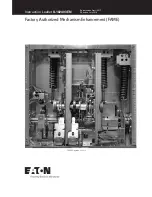
63
3
Selection and application
3-6 Applications on the primary side of transformers
3-6-2
Selecting an MCCB for transformer
primary circuit
The MCCB to be selected must be capable of carrying
the rated current safely in the normal condition, without
malfunctioning with the inrush current for exciting the
transformer.
More specifically, the MCCB is required to meet the following
relation:
2
u
Ii > k
u
l
T1
where
Ii: MCCB instantaneous trip current (effective value)
I
T1
: Transformer rated primary current (A) (peak value)
k: Transformer exciting inrush current multiplier
This relation is illustrated in Fig. 3-21.
Fig. 3-21 Relationship of induction voltage to magnetic flux in a
steady-state transformer
I
N
I
N
T I
T1
I
i
MCCB operating
characteristic
Transformer
exciting inrush
current
Current
Time
Transformer exciting inrush current and MCCB
operating characteristic
To select an MCCB for line protection, if the instantaneous trip
current (Ii) is eight times the rated MCCB current (In), and the
transformer exciting inrush current multiplier (k) is 20 (typical
value for 100kVA class transformers), the following relation
holds:
2
u
8
u
I
n
> 20
u
l
T1
This suggests that an MCCB with its rated current at least 1.8
times higher than the transformer rated primary current must
be selected.
MCCBs designed for transformer primary circuits have their
operating characteristics set up to meet the above conditions,
and feature a rated current lower than that of an MCCB for line
protection. Table 3-15 and 3-16 show single-phase transformer
applications while Fig. 3-17 and 3-18 show three-phase
transformer applications.
3-6-1 Inrush current for transformer excitation
The voltage V applied to the transformer in the normal
condition is balanced by the voltage
e
induced by changes in
the magnetic flux in the core. Only a slight exciting current is
needed to generate the flux flows through the primary winding.
The following relationship exists between the induced voltage
e
, the instantaneous value
ø
of the magnetic flux, and the
primary winding
n
:
dø
dt
e=n
where e = E
m
sin
Z
t yields ø = −ø
m
cos
Z
t + C. In a steady state
(C = 0), the relationship is like that shown in Fig. 3-19.
Fig. 3-19 Relationship of induction voltage to magnetic flux in a
steady-state transformer
ø
ø
m
e
t=0
0
Accordingly, assuming that excitation of the transformer
is started at t=0, the magnetic flux ø must be 0 if the prior
residual flux is 0. The flux exhibits ø as shown in Fig.
3-20, which is far above the core saturation flux ø
s
of the
transformer. However, as the magnetic flux ø is saturated to
the value of ø
s
for the period from t
1
to t
2
, the induced voltage
dø
dt
e=n
is no longer balanced with the voltage V applied to the
transformer, when a difference is created between the voltage
V applied to the transformer and induced voltage e. As a
result, inrush current i flows through the primary winding of the
transformer (Fig. 3-20).
Fig. 3-20 Transformer excitation inrush current
2ø
m
0
t=0
t
1
t
2
i
ø
ø
s
When the transformer core has residual magnetic flux, then
the amount of inrush current and the amount of saturation will
increase by the amount of flux present. An MCCB is generally
made near voltage phase
S
/2 to prevent excitation inrush
current. With a three-phase transformer, however, it is done by
making the MCCB near voltage phase 0 at some phase.
The magnitude of the inrush current for excitation is generally
stated as an exciting inrush current multiplier (exciting inrush
current first peak value relative to the transformer rated
primary current peak value).
The exciting inrush current multiplier is a parameter of the
transformer ratings and design. Generally, the lower the
transformer capacity, the larger the exciting inrush current
multiplier and the shorter the time constant.
3-6 Applications on the primary side of transformers















































